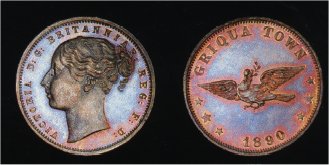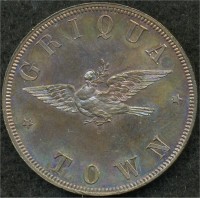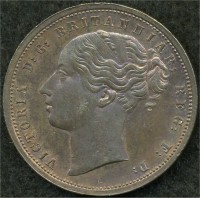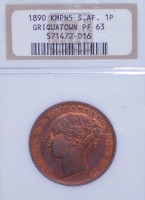The Griqua Town Pattern 1890 Pennies -
unissued (Fuld) Rarity Scale: between R-5 & R-6)
 There are two varieties - the main
visible difference being one dated 1890 and the other being
undated. Both extremely rare varieties are held in Proof-like condition
by the Balson Holdings Family Trust. It is estimated that about 50
undated and about 100 dated patterns were struck. Just a few pieces can be
found in proof-like condition seen below.
There are two varieties - the main
visible difference being one dated 1890 and the other being
undated. Both extremely rare varieties are held in Proof-like condition
by the Balson Holdings Family Trust. It is estimated that about 50
undated and about 100 dated patterns were struck. Just a few pieces can be
found in proof-like condition seen below.
Griqua Town is located in Griqualand West near Kimberley, the epicenter of
the South African diamond mining industry. It is one of the earliest settlements
in central South Africa. It was previously known as "Klaarwater" the
name change for, what was then a small village, came after a visit by the
Rev John Campbell who recorded in his diary on the 7th August 1813,
"We had a meeting with all the male inhabitants
of the settlement who were in the town (Klaarwater) to consider various points,
especially about regulations for the protection of lives and property of
the community…. every person present considered that laws should be
made… The whole people likewise resolved that henceforth they should
be called the Griquas instead of Bastard Hottentots and the place be called
Griqua-town instead of Klaarwater".
The region was administered by Great Britain from 1871, becoming part of
the Cape Colony in 1880. There are two pattern coins, one dated 1890 and
the other of similar design but undated which were struck in minuscule
quantities by Otto Nolte & Co. of Berlin, Germany, from dies prepared
by L.C. Lauer of Nuremburg and are extremely rare.
There are several stories attributed to the production of these Griqua
Town patterns.
One asserts that they were produced on a speculative basis in anticipation
of Griqualand's independence after their disastrous trek over the Drakensberg
in the 1860s into Nomansland - this is unlikely as the Griquas had no assets
and could not have afforded such a venture - especially after their earlier
failed bank note escapade. Perhaps the best
evidence supporting this claim is recorded in the book
"The Griquas of South Africa and their Money".
Another story is simply that Nolte had them struck as showpiece items used
in helping him market his minting services in Europe. Jerry Remick is silent
on that point in his Commonwealth catalog.
The most plausible story is recorded in the covering preamble by Spink
and Sons South African agent, City Coins of Cape Town, Dr Frank Mitchell,
a Fellow of the South African Numismatic Society, when the coin below, came
up for auction in 1985. Mitchell claims that (see text in yellow block below):
"The patterns were struck in Germany between 1874 and 1890 in an endeavour
to solicit orders from the Transvaal Republic (the ZAR); the Orange Free
State and the Cape..." (See Frank Mitchell's
correspondence to Scott Balson at this link).
| Gone they were, but not entirely forgotten. In far off
Germany, in 1890, someone remembered that there was a nation at a place called
Griqua Town ... Following the international excitement precipitated by the
discovery of gold in the Transvaal, and having no doubt received reports
of the preliminary issue of gold staatsponden by the Transvaal Government
under President Burgers in 1874, an enterprising German coin manufacturing
firm Otto Nolte and Co of Berlin produced, between 1874 and 1890, a series
of sample or "pattern" coins of various denominations and in a variety of
metals for the Transvaal, for the Orange Free State and for the Cape of Good
Hope. Tenders were submitted (unsuccessfully as it turned out) to the three
governments, offering to strike coins for them. In the same series two different
pattern pennies for Griqua Town were struck in bronze in very small sample
numbers.
Source: The Coinage of Griqua Town by Dr
F K Mitchell |
The Dated 1890 Griqua Town Pattern "Penny" in
Proof-like condition
The dated 1890 Griqua Town Proof Penny

This coin was purchased by the Balson Family Trust in 2004 from well known
numismatist Ronald Carlson of McKinney, Texas for US$580. Carlson purchased
the coin from the City Coins auction in 1985. The coin previously
formed part of the Richard J Ford collection. This coin has been graded
slabbed by the Numismatic Guaranty Corporation of America and is
graded as PF 63.
(You can click on the images above for a screen
size view of each side)
The growing global demand for Griqua pieces is best represented by the
interest in this piece offered in April 2005 on eBay
(click here for image) the coin
sold for over US$1,300 after hot bidding with 30 bids being cast - this piece
is of much lower quality than the one displayed above.
The Undated 1890 Griqua Town Pattern "Penny"
in Proof-like condition
The pattern below held by the Balson Holdings Family Trust
is the Proof 1890 Griqua Town penny without the date - also with a beautiful
patina. It was secured in September 2005 (Signature Auction 387) through
an auction on HeritageCoins.com for just US$1,250 - 14 bidders
participated in this auction (see screen dump below the coin thumbnails displayed
below). A year earlier this same coin sold for US$750 demonstrating a dramatic
global growth in the value of and interest in Griqua pieces..
The reverse of the coin below (click for full screen images) is exactly
the same as the coin above.


The record of interest in the undated Griqua Town Proof Penny secured by
the Balson Holdings Family Trust

Value in 2005: The Griqua Pattern coins are
highly sought after - valued at US$3,000 in Unc.
Rarely seen on auction. A Prooflike piece with blemishes
sold on eBay in January 2006 for US$7,100 (see link below).

The Balson Holdings Family Trust Griqua 1890 pair (seen above)
The two 1890 Griqua Patterns above reflect the finest pair in the world
today.
The dated coin from the Richard J Ford collection is, according to
Solid Gold Consultants in South Africa, a unique piece being rated at PF
(Proof) 63 by the ANA. In their company profile the company says,
Solid Gold Consultants SA PTY (LTD) has been in
existence for almost ten years. We are essentially a brokerage that sources
and sells the highest quality coins for or on behalf of our clients. Our
credo is that of professionalism, service, integrity and
proficiency.
In November 2004 Solid Gold Consultants sold these two Griqua pieces as
investment pieces while claiming that The mintage
reports state that no Griqua Penny was struck as a proof and only
an estimated 50 coins of the one, and 100 of the other, were struck for
presentation purposes. The origin of these mintage numbers is unknown and questionable. Both coins are equally rare with mintages under 100.
An example of the explosion in the value of Griqua
related coins and bank notes can be seen at this link
[1815/16 Griqua Town "coins"]
[1860: Durban Club 6d] [1862 Durban
Bank £5 Bank Note] [1868: Griqua £1 Bank
Note]
[1874: Mount Currie Express Stamp]
[1874/1932: Strachan and Co Currency Tokens]
[1876 Pietermaritzburg Franklin Penny]
[Other E Griqualand Tokens]
[1870s Griqua Town
Patterns] [1890: Griqua Patterns]
[Other Serious Griqua Coin Collectors]
[The History of the Griqua People]
[Griqua Token Coins, Coins and Bank Notes]
[Web Site Text Site Map]
[Tokencoins.com Home Page]
[Other South African Metal Token Coins]

 There are two varieties - the main
visible difference being one dated 1890 and the other being
undated. Both extremely rare varieties are held in Proof-like condition
by the Balson Holdings Family Trust. It is estimated that about 50
undated and about 100 dated patterns were struck. Just a few pieces can be
found in proof-like condition seen below.
There are two varieties - the main
visible difference being one dated 1890 and the other being
undated. Both extremely rare varieties are held in Proof-like condition
by the Balson Holdings Family Trust. It is estimated that about 50
undated and about 100 dated patterns were struck. Just a few pieces can be
found in proof-like condition seen below.





